In January of 1895, a warehouse fire ignited a large store of dynamite resulting in a great explosion that devastated several blocks of Butte, Montana, and killed an estimated 58 people. The following account is partial text from the 1895 publication “The Great Dynamite Explosions at Butte, Montana: January 15, 1895”
The Fire and Explosions
At five minutes of 10 o’clock on the night of January 15, 1895, an alarm of fire rang out from the bell tower on the City Hall. Quickly the horses jumped from their stalls. In a twinkling the harness was on, and nine fireman mounted their seats and sped away to the scene of the fire, and soon a stream of water was playing on the flames that were darting their defiant tongues into the air from the roof of the Kenyon-Connell warehouse, somewhat over a mile away.
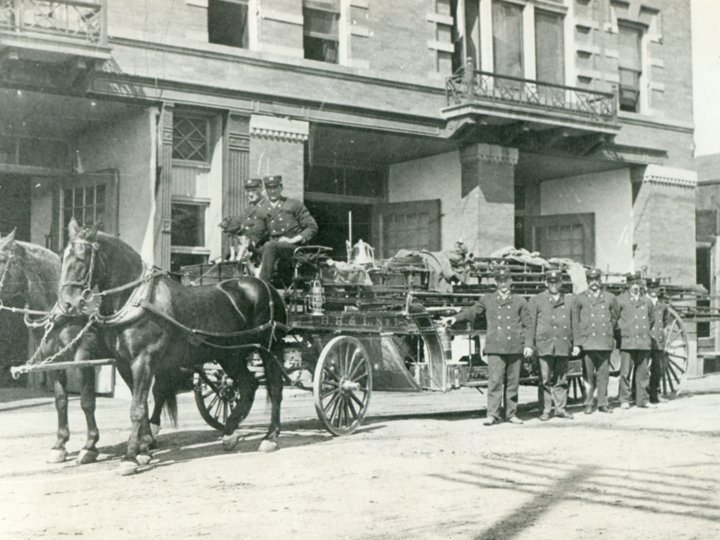
The location is easily conceived. Railroad tracks, sheds and cars, with mercantile warehouses interspersed, are common features of all cities. In Butte large space is devoted to these features, as here three great transcontinental lines meet, and meet nowhere else for hundreds of miles.
The nine regular fireman were joined by several volunteers and the men were busy with the work of unrolling hoses, blanketing the horses, and preparing the ladders. Just at the moment when the first water struck the fire there was a puff within the building, throwing up flames and cinders. The firemen stepped back a moment, but being reassured, immediately resumed their positions.
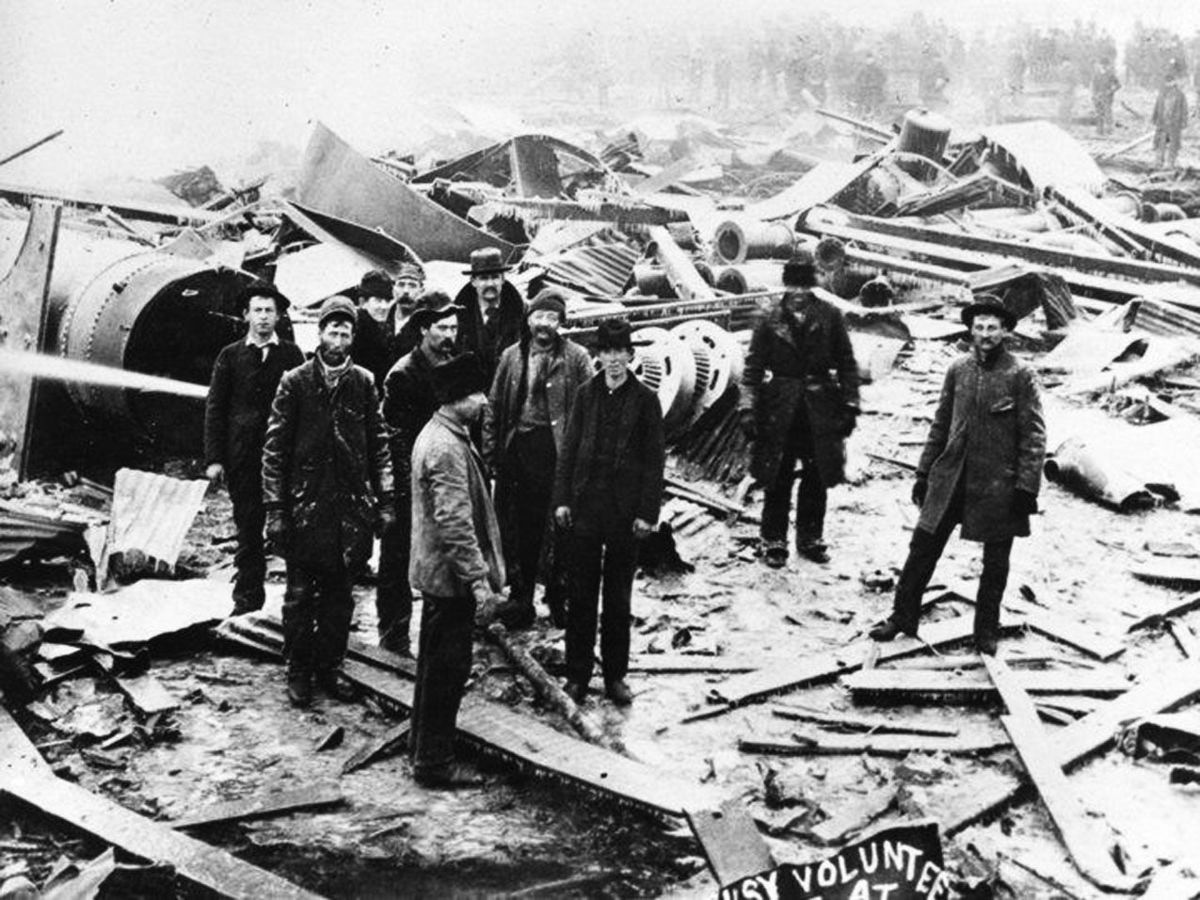
Directly after there was a flash and an awful roar. The iron roof was lifted a hundred feet in the air, while a pillar of fire, a shock as of a violent earthquake, and a sound as of the concentrated fire of many cannon were experienced for a distance of miles on miles. The air was filled with cries of anguish and the groans of dying men. Every one of these intrepid firemen was instantly killed, save Flannery and Magee.
Magee had been blanketing his horses when the explosion occurred. It was the first time during the winter that he had found it necessary to do so, and he was standing with the horses between him and the fire when the explosion came. To this fact he owes his life. One of the horses was killed and fell on him, breaking his leg and pinning him fast to the earth.
As soon as people could recover themselves after the shock of the first explosion, they hurried to the scene from all parts of the city, and began the work of caring for the dead and injured. While engaged in this humane task, there came a second and third fierce explosion.
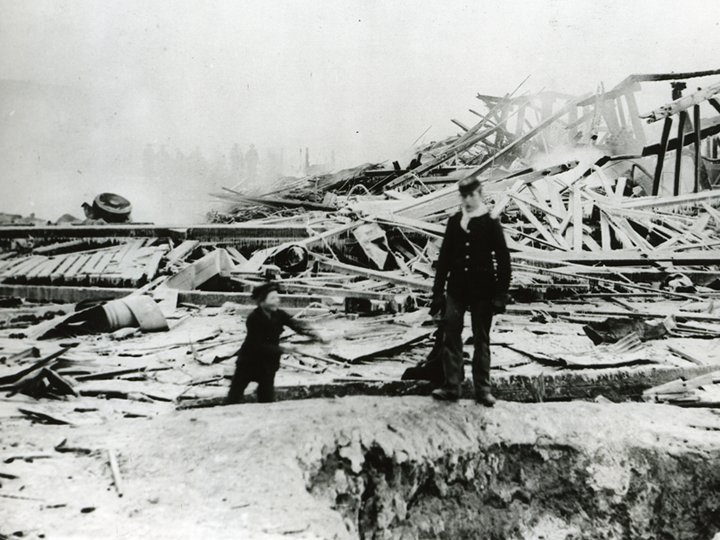
Then indeed was there devastation and death! Dead bodies by the score were lying everywhere about, while many others were helpless from their wounds. A fourth and last explosion, not so heavy as the second and third, soon followed, adding yet more to the fearful destruction.
The warehouses had contained the usual stock stored in such places, including stoves and ranges, sheets of corrugated iron, gas pipe, coils of wire and wire netting, iron wheelbarrows and rabble-heads—pieces of iron about six inches long, four inches wide and a half-inch thick-and weighing about four pounds and a half. For greater security, these latter had been piled up around the sides of the room in which the dynamite was stored.
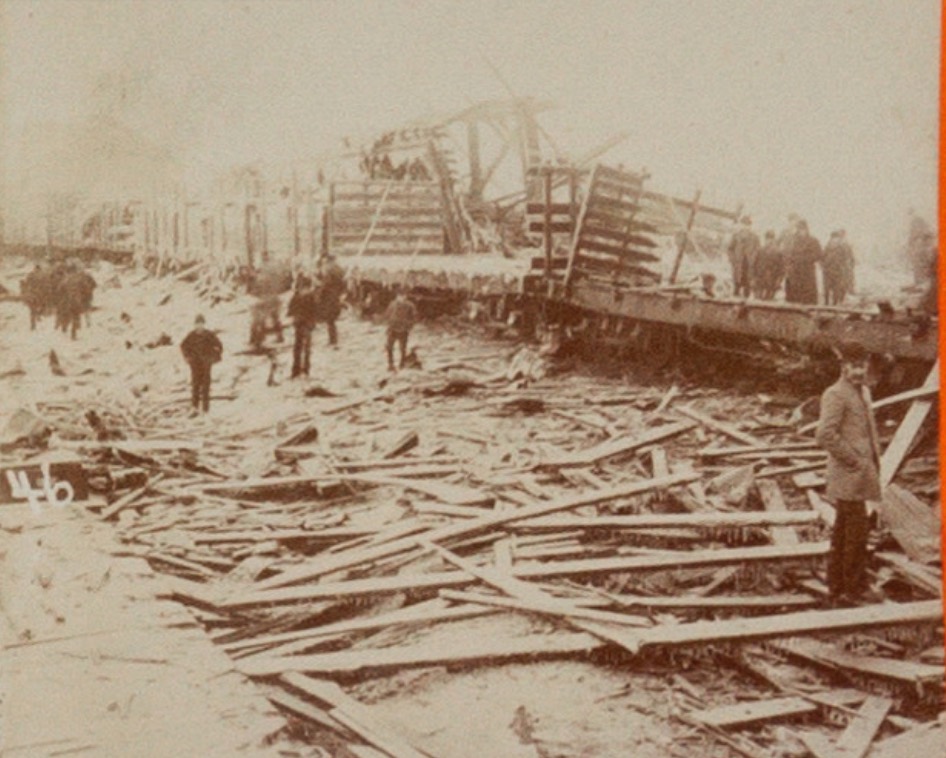
The force of the explosions hurled these articles in every direction, and they constituted a large part of the destroying element, cutting down relentlessly the human beings that stood in their way, as grass is mown in a summer field.
The scene that followed will live forever in the memories of those who witnessed it. Scarce a timber of the six or more adjacent warehouses was left standing. Debris of various kinds, piled up in inextricable confusion; the fire still burning; the apparatus of the fire department wrecked and scattered; the ground covered with the wounded, dead and dying; the living hurriedly giving what aid they could and tenderly placing the wounded in carriages and vehicles that had hastened to the spot to offer their services.
The scenes at the morgue were sad in the extreme. Crowds of excited people, both men and women, surged round the doors, struggling for admittance, hoping that among the pieces of shattered humanity, were none dear to them, yet fearing the worst.
When the dread apprehension became a reality–and such it proved in many a case-the cries of anguish were heart-rending, and many a strong man was moved to tears.
The Aftermath
In the chaos that reigned on the night of the fire, it was difficult to estimate the full extent of the disaster, or even to realize its horror. Although all of the bodies that could be found were removed during the night, the light of the morning revealed a scene of blackness and desolation that bore silent witness to the awful destruction.
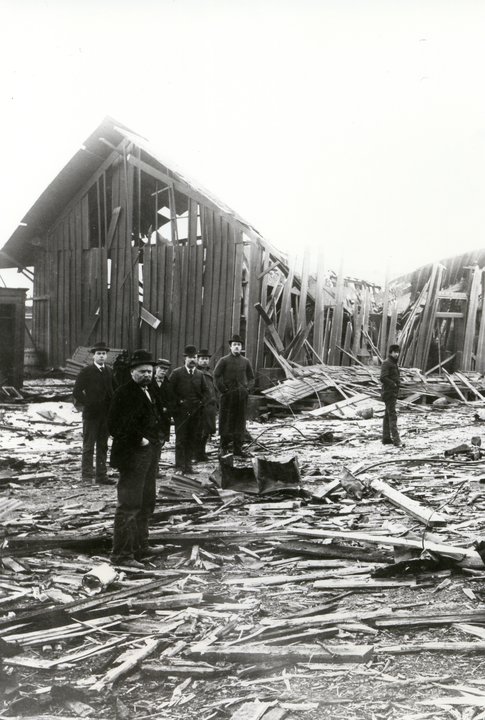
People hurried to the spot from all parts of the city; and while Some stood benumbed at the sight, others assisted in the search for the fragments of humanity scattered through the ruins. Several basketfuls of these were collected and taken to the morgue. Every part of the burnt district was carefully examined and the debris turned over at the time, yet pieces of bone were found two weeks after the fire.
Compared with the loss of life, the destruction of property was insignificant. Probably $100,000 would cover the loss at the immediate scene, while a fraction of that amount would replace the broken glass that littered the sidewalks of the city, in decreasing amounts, to the distance of two miles.
The buildings burned covered a comparatively small area, but between the fire and explosions, the destruction was complete. Not a timber or stone was left standing in the three westernmost warehouses, and everything combustible had been devoured by the fiery element.
A piece of large-sized gas pipe, reported to have killed seven men, as it was hurled with giant force through the air, fell across two other pieces in such a way as to form a three-sided figure. It was known among the surviving firemen as “the fatal triangle.”
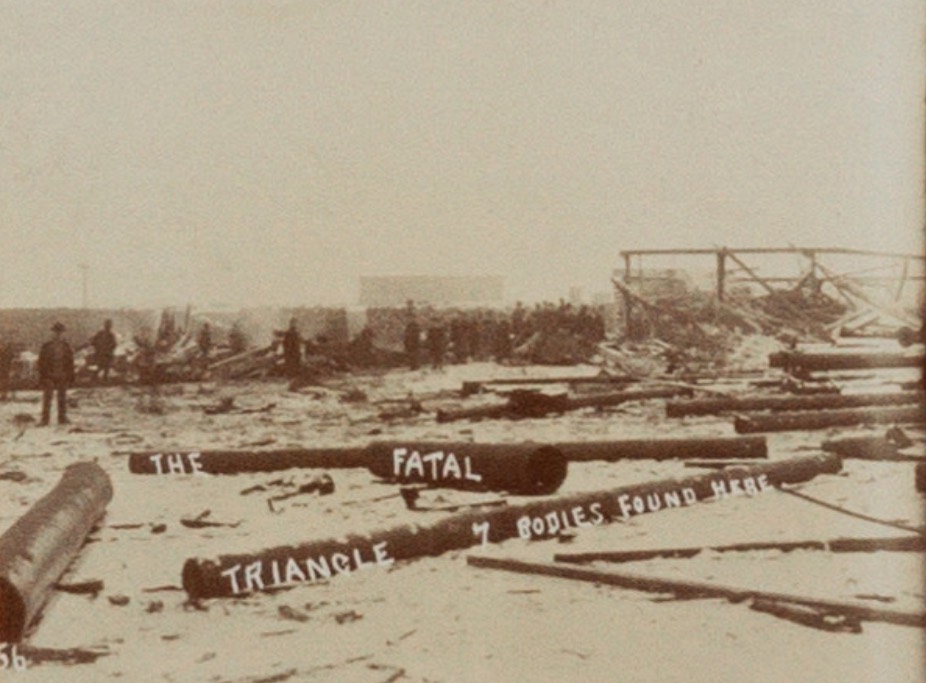
The identification of bodies was, in many instances, exceedingly difficult. A shred of clothing, a button, some small article known to have belonged to the person sought for, a letter or picture in the pocket, were often the only means by which it could be identified.
In one case, a young man had just purchased a pair of shoes. He was walking down the street with the package under his arm, when his attention was attracted toward the fire. Like many another, he went to his doom. The shoes were found not far from the fire, and led to the discovery of his body.
It was most difficult to fix the identity of the brave firemen who, intent on their duty, were very near the building where the first large explosion occurred. The bodies of Chief Cameron and Firemen Ash, Moses and Norling, were all so frightfully shattered and torn as to be unrecognizable. Even the poor comfort of definite knowledge concerning their bodies was denied their families and friends, and formed no small part of their grief.
Side by side with some of the worst fatalities were many strange escapes. Notable among them was that of William Orr, one of the volunteer firemen. When the first heavy explosion occurred, he was with Firemen Moses, Ash and Sloan, handling the hose, a few feet from the north side of the KenyonConnell warehouse. There is always a heavy pressure in South Butte, and it requires four or five men to handle a line of hose. He had just turned his back to the building to ease up on the hose, when he suddenly found himself lying near a shed, about 250 feet from where he had been standing. A dead body was lying across him.
Even more remarkable was the experience of a man who stood beside a friend, watching the progress of the fire. The friend was instantly killed, and he found himself covered with blood, but absolutely unhurt.
The Funeral
The morning of January 18, dawned clear and bright, as if to give some poor cheer to the saddened people of the striken city; but it was powerless to dispel the gloom that rested everywhere with the blackness of despair. On this day the last kindly services were to be rendered the heroic dead, and they were to be tenderly carried to their long resting place in the valley.
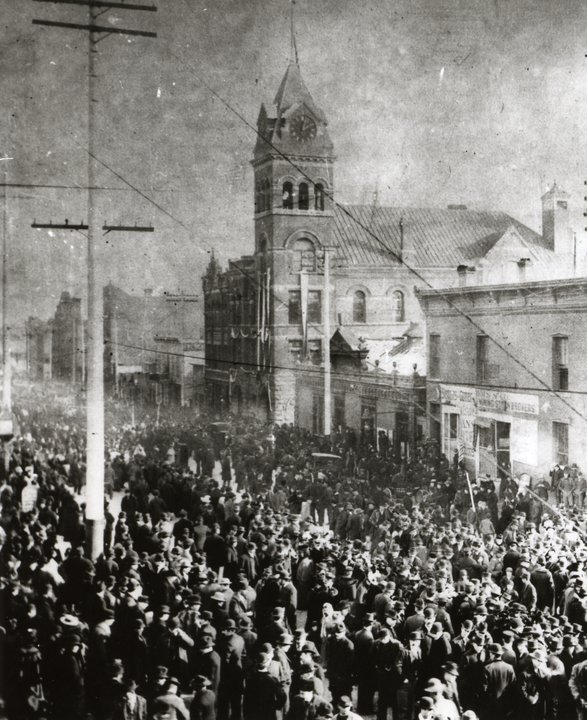
All of the business houses were closed and the citizens gave their whole thought to the closing scenes of the awful tragedy. People came from all parts of the state, including large delegations from the fire departments of the various cities, to honor the memory of their comrades.
Between 1 and 2 o’clock in the afternoon the funeral procession began to form at the City Hall, from where it was to start. The streets were thronged by crowds of people with saddened, tear-stained faces, their hearts aching with sympathy for those over whom the Angel of Death had cast his black shadow.
About 2 o’clock Companies B, F and G of the National Guard, with the Regimental band, took their places in front of the City Hall, as it was deemed appropriate to bury with military honors the men who had shown such fearlessness in the performance of duty, and by reason of which they had lost their lives.
The arrangements for the funeral procession were characterized by great simplicity, and were thereby made the more impressive. The mournful strains of the funeral dirge, the muffled drum-beat, the bell in the City Hall tolling its last farewell to those who had so often responded to its tones, the lowered flags and the fire. Wagons draped in sombre emblems, were fitting accompaniments to this pageant of woe.
The funeral procession included 3,000 men, representing all classes. Never before, in the history of Butte, where processions are of frequent occurrence, had there, been an occasion where so many took this means of showing their interest in a public event. When the head of the procession reached the cemetery the rear had not yet turned into Montana street from Park.
Just outside the gates of the cemetery, the troops filed to one side of the street, and as the hearses and firemen passed they presented arms. Inside the burial grounds the column disbanded and the dead were borne to the graves prepared for them. Here the scene was one of great sadness.
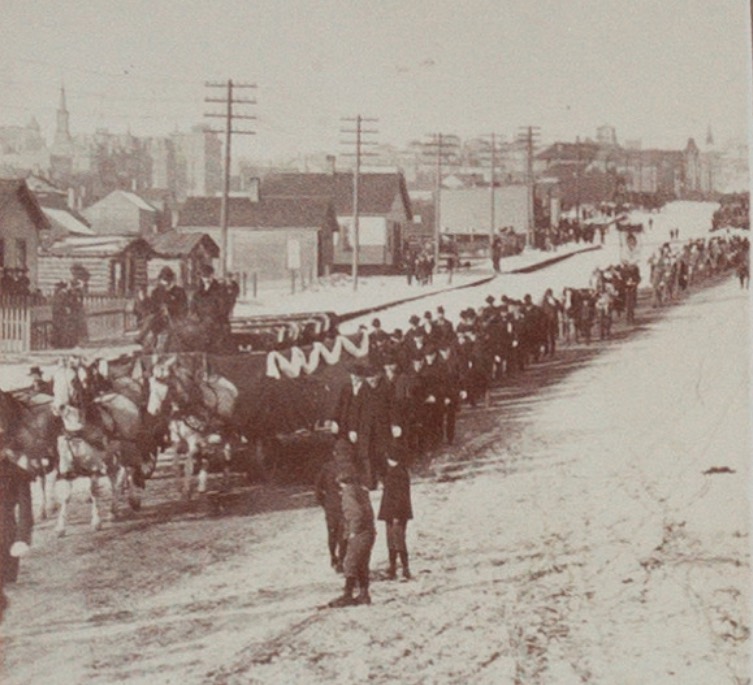
The deepest grief was everywhere evident, and strong men wept like children. The nine friendless dead were buried side by side. Thirty bodies in all were consigned to the grave that day, among them that of Police Officer Krambeck, six policemen acting as pall-bearers.
The painful duty of burying the dead was begun the day before, and there were a number of funerals the day after, but the end was not yet; for several had lingered in mortal agony at their homes or the various hospitals, where they were tenderly cared for, but all that the skill of physicians and nurses could do was in vain. Their injuries were such as no human nature could withstand, and these were added to the already frightfully long list.